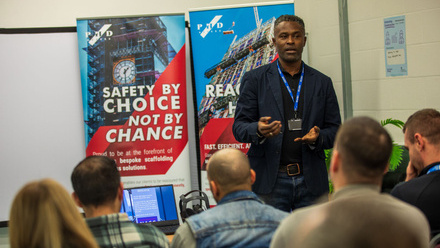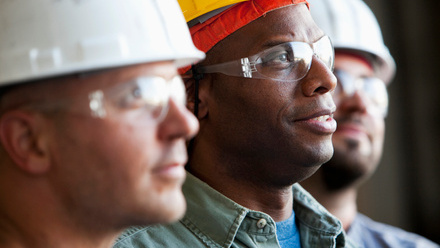This was the reality that Katrina Dowding faced on day one at her first job onsite. Undeterred, she took it in her stride and went on to forge a successful career in construction. Fast-forward less than 30 years since that day and she is now the Executive Vice President at Skanska – one of the world’s leading project development and construction groups.
Katrina shared this story, along with other insights into some of the challenges of being a female in the construction industry, with an audience of 500 people at the Women in Construction Summit on 6th March in London.
The inaugural summit provided a forum for discussions, interactive skills workshops and inspirational keynote presentations focusing on how to address gender imbalance in the construction industry.
The event also celebrated the role and contribution of women in the industry and called for more action to be taken to challenge business cultures and industry perception, make progress on diversity and inclusion policies and empower more women to become leaders and role models.
While some progress towards these goals has been made in recent years, current figures show women account for just 11% of the construction workforce and only 2% of tradespeople.
The suggested solutions to these challenges was addressed by the speakers, with three key themes emerging from the presentations:
Education of career choices is vital
As Katrina Dowding explained: “Education of career choices starts when kids are in primary school.”
As one of only five women in a class of 65 at university, and the only female to graduate, Katrina is a role model for the younger generations and her formula for success in a male-dominated industry is simple: “Nobody told me I couldn’t do the job I’m doing today. Or maybe they did, and maybe I didn’t listen.”
Young people are seen as an important demographic because the future of the construction industry lies in their hands. With an ageing workforce, fewer apprenticeships on offer and the uncertainty of Brexit’s impact, the industry is facing a major skills shortage. To ensure the future viability of the industry, the summit speakers argued that more needs to be done to promote the benefits of a career in construction to young people, both men and women, from a young age.
Many of the speakers advocated the need for workshops and presentations at schools and adaptations to curriculums to promote different career paths and reduce the underlying impacts of outdated gender stereotyping.
“We need more women to choose to study subjects that lead to construction-related qualifications and we need more women to go on to choose careers in construction,” said Marina Robertson, Director of Operations, London at NPS Group.
To achieve greater female representation in the industry, more women need to be encouraged to pursue a career in construction as well as being educated about the diversity of opportunities within the sector.
We need to paint a new image for construction
To create real impact through education, the industry needs to improve its public perception. Construction work is still largely perceived to be a ‘man’s job’ and this belief is reinforced through language and messaging, as well as advertising, websites and publications where images of men are frequently used to represent the industry.
While these images may be reflective of the actual working environment, Marina Robertson advocated that it is time for an industry makeover. In order to attract more women to the sector, the industry needs to stop portraying a male-dominated environment and start promoting the role of women to appeal to a female audience.
As was evidenced at the summit, stories of other women making progress in the industry can provide a source of inspiration for other women. Erica Gasbarro, Consulting Services Manager at Grid Plan highlighted the impact of the women in attendance at the summit. “Every woman in this room is shattering the idea that women don’t belong in construction,” she said.
Diversity and inclusion impacts a business’s bottom line
Research suggests that more diverse teams make better quality decisions that lead to increased business and financial performance, but Alice Jennison Equality Diversity and Inclusion Manager at Costain Skanska Joint Venture suggested businesses should think about creating inclusive workplaces first. “Inclusivity enables diversity to happen quicker and add value to your business,” she said.
Gabi Hazelden, Lead NEC Supervisor at Tideway, which aims to achieve gender parity by 2023, outlined the initiatives it implements to create a more inclusive environment. These included a Returners Programme for those re-entering the workplace, flexible working arrangements, PPE that is culturally sensitive and fitted to women’s body shapes (including maternity options) and implementing new policies and practices.
These are just some examples of activities that help to create a more inclusive environment for all employees, both men and women. While some activities may seem like common sense – like ensuring access to female toilets – they are currently not standard practice across the industry.
Jordan Graham, Producer of the Women in Construction Summit, said the event provided a great platform for women to inspire each other and strive for change in the industry.
“Experiencing the energy of our 500 attendees and speakers was amazing. I’ve been truly moved by the feedback from attendees since the event, who have told us that they feel inspired, empowered and more confident. We also aimed to create a push for greater equality in the industry and so the event has been a huge success.
“I cannot wait for next year where we can get more people involved, grow the movement and start seeing tangible results.”
Brian Berry, Chief Executive of the Federation of Master Builders (FMB) said: “Events such as this help to shine a light on the great work that is being done to encourage and support women in construction.
“But they also demonstrate that as an industry we have a long way to go to achieve gender equality. We need to continue our efforts to improve the culture and perception of our industry to ensure we can attract and retain diverse workforces in the future.
“Our research suggests there is growing consumer demand to see more women in the industry and onsite and we continue to encourage parents, teachers and career advisers to talk to young women about seriously considering a career in construction.”
For more information on the Women in Construction Summit, visit www.womeninconstructionsummit.com





